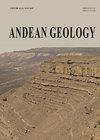阿根廷卡林加斯塔-乌斯帕拉塔盆地Aseptella-Tuberculatella/Rhipidomella-Micraphelia(晚期Serpukhovian-Bashkiriano)动物群的最南端记录
IF 1.2
4区 地球科学
Q3 GEOLOGY
引用次数: 3
摘要
Agua del Jaguel组产于阿根廷中西部Calingasta Uspallata盆地的最南端。该单元的下部以含杂岩的冰川序列和含落石的泥岩为特征。在后者中,结核足类/小缝足类动物群(AT/RM动物群)的元素,如腕足类Rhipideomella discita Cisterna、小缝足属Simanauskas和Cisterna和Orbiculoidea?sp.,腹足类Murchisonia?sp.和Glabrocingulum(Stenozone)?sp.,双壳类裸藻科。,褶皱珊瑚,以及鹦鹉螺和舌骨类的不确定碎片已经被确认。该动物群的重要性主要在于其古环境和生物地层学意义。AT/RM动物群的特征是海底氧气和营养物质浓度相对较低的受限环境,这与Agua del Jaguel组所建议的峡湾型海岸的冰川海洋序列一致。与位于盆地北部的埃尔帕索组相比,该单元的动物群多样性相对较低,这可能表明与古河谷与海水隔离有关的底栖生物定殖区更受限制。Serpukhovian Bashkirian晚期的冰川后泥岩和海洋无脊椎动物群可能沉积在Uspallata Calingasta盆地相对受限的(古峡湾)部分以及开放陆架环境中。在截然不同的海岸结构和水柱中营养物质和氧气的可用性上发生的海洋洪水会促进动物群的发展,在同一时间间隔内,动物群在分类学组成和古生态结构(AT/RM和Levipustula动物群)上存在重要差异。Agua del Jaguel组的辐射数据和盆地冰后沉积序列的古生物记录(海洋无脊椎动物、坡缕菌和植物)是调整冰后海侵时间的最重要工具。本文提供的这些信息补充了针对整个冈瓦纳大陆中西部石炭系序列提出的方案,但不足以确定晚谢尔普霍夫阶-巴什基尔阶区间内研究的动物群的更精确年龄。本文章由计算机程序翻译,如有差异,请以英文原文为准。
El registro más austral de la Fauna Aseptella-Tuberculatella / Rhipidomella-Micraphelia (Serpukhoviano tardío-Bashkiriano) en la cuenca Calingasta-Uspallata, Argentina
The Agua del Jaguel Formation crops out in the southernmost part of the Calingasta-Uspallata basin, in central western Argentina. The lower part of the unit is characterized by a glacigenic sequence with diamictites and mudstones with dropstones. In the latter, elements of the Aseptella-Tuberculatella/Rhipidomella-Micraphelia Fauna (AT/RM Fauna), such as the brachiopods Rhipidomella discreta Cisterna, Micraphelia indianae Simanauskas and Cisterna and Orbiculoidea? sp., the gastropods Murchisonia? sp., and Glabrocingulum (Stenozone)? sp., the bivalve Nuculanidae indet., rugose corals, and indeterminate fragments of nautiloids and hyolithids, have been identified. The importance of this fauna mainly resides in its paleoenvironmental and biostratigraphic implications. AT/RM Fauna is characteristic of restricted environments with relatively low concentrations of oxygen and nutrients in the seafloor, which is consistent with the glaciomarine sequences in fjord-type coasts suggested for the Agua del Jaguel Formation. The relatively low diversity of the fauna in this unit compared to that defined in the El Paso Formation, located further north in the basin, might suggest more restricted sectors for benthic colonization, related to the paleovalle’s isolation from oceanic waters. The postglacial mudstones with marine invertebrate faunas of late Serpukhovian-Bashkirian age would have been deposited in relatively restricted (palaeofjord) part of the Uspallata-Calingasta basin as well as in open shelf environments. The marine flooding over drastically different coast configurations and the availability of nutrient and oxygen in the water column would have propitiated the development of faunas with important differences in the taxonomic composition and the paleoecological structure (AT/RM and Levipustula Faunas) occurring at the same time interval. Radiometric data in Agua del Jaguel Formation and paleontological records in the glacial-postglacial sedimentary succession in the basin (marine invertebrate faunas, palynomorphs and plants) are the most important tools to adjust the timing of the postglacial transgression. This information herein presented complements the scheme proposed for the Carboniferous sequences throughout the central western of Gondwana but is not sufficient to assign a more precise age of the fauna studied within the late Serpukhovian-Bashkirian interval.
求助全文
通过发布文献求助,成功后即可免费获取论文全文。
去求助
来源期刊

Andean Geology
地学-地质学
CiteScore
3.90
自引率
0.00%
发文量
17
审稿时长
>12 weeks
期刊介绍:
This journal publishes original and review articles on geology and related sciences, in Spanish or English, in three issues a year (January, May and September). Articles or notes on major topics of broad interest in Earth Sciences dealing with the geology of South and Central America and Antarctica, and particularly of the Andes, are welcomed.
The journal is interested in publishing thematic sets of papers and accepts articles dealing with systematic Paleontology only if their main focus is the chronostratigraphical, paleoecological and/or paleogeographical importance of the taxa described therein.
 求助内容:
求助内容: 应助结果提醒方式:
应助结果提醒方式:


